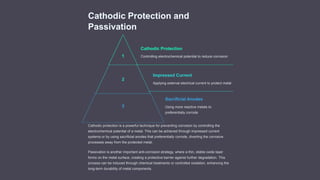The document outlines the principles of electrochemistry, focusing on galvanic cells, battery types, electrolysis, and corrosion mechanisms. It details how electrochemical potential drives reactions and applications in energy storage and metal extraction. Key strategies for corrosion prevention, such as cathodic protection and passivation, are also discussed, emphasizing their importance in protecting metal infrastructure.
















